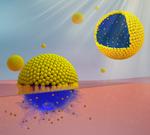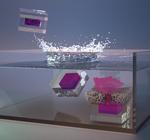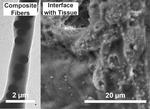John L. Daristotle
Postdoctoral Associate
Jaklenec Group + Langer Lab, Koch Institute for Integrative Cancer Research at MIT
Biography
I am a postdoctoral researcher in the Jaklenec Group at the Langer Lab. My research projects include:
- engineering biodegradable polymers for vaccine delivery
- polymer processing for biomedical applications
- drug delivery systems for nucleic acid-based therapeutics
- immunomodulatory biomaterials
Interests
- drug delivery
- polymer processing
- immunoengineering
- surgical materials
Education
PhD in Bioengineering, 2019
University of Maryland
BS in Chemical and Biomolecular Engineering, 2014
University of Maryland
Experience
Postdoctoral Associate
Jaklenec Group + Langer Lab, Koch Institute for Integrative Cancer Research at MIT
Engineering drug delivery systems for vaccines using microfabricated polymers
Graduate Research Assistant
Functional Macromolecular Lab @ University of Maryland, College Park
Sprayable, biodegradable polymer blends for tissue adhesion
Recent Publications
Quickly discover relevant content by filtering publications.
Evaluation of healing outcomes combining a novel polymer formulation with autologous skin cell suspension to treat deep partial and full thickness wounds in a porcine model: a pilot study
Autologous skin cell suspensions (ASCS) can treat burns of varying depths with the advantage of reduced donor site wound burden. The …
Recent & Upcoming Talks
Intrinsically Adhesive Polymer Wound Dressing with Antimicrobial Properties
Conventional wound dressings are adhesive-coated thin films. They adhere primarily to healthy skin surrounding the wound, and have limited exudate absorption. Here, we demonstrate that polymer blend fibers can be sprayed directly into a partial-thickness skin wound using solution blow spinning, a fiber spinning technique. Due to a body temperature-mediated softening event, the fibrous wound dressing can stick immediately to the wound and skin. Within 3 days, the porous wound dressing has absorbed a significant amount of wound exudate, creating a polymer-scab hybrid material that is strongly bound to the wound. As a result, this wound dressing required 75% fewer dressing changes than a clinical control wound dressing. We tracked a number of additional wound healing metrics. Vascularization, as measured by blood vessel density in the healing wound, was significantly increased. Dermis and epidermis thickness, collagen content, and various gene and cytokine expression levels were comparable between dressings. We also engineered the controlled release of silver nitrate, a potent antimicrobial agent, without compromising adhesion or cytotoxicity.
Adhesive Polymer Composite Wound Dressings: Silver and Silica for Antimicrobial and Hemostatic Applications
Wound closure devices prevent excessive blood loss and exposure to pathogens, whether for internal or external use. Conformal, adhesive dressings improve upon conventional wound closure devices such as sutures by minimizing collateral damage to tissue and providing a leak-proof seal. In this work, we demonstrate how solution blow spinning (SBS) can be used to spray-deliver polymer composite dressings in situ–and how the composite element delivers advanced functionality, either by (1) releasing silver ions to prevent infection or (2) by incorporating silica particles to reduce coagulation time. Both approaches utilize a body temperature-responsive biodegradable polymer blend of poly(lactic-co-glycolic acid) and poly(ethylene glycol) (PLGA/PEG) with minimal cytotoxicity.
Incorporating silica particles improves the adhesion, flexibility, and hemostatic efficacy of a polymer blend surgical sealant
Surgical sealants are supplements to conventional wound closure devices that augment hemostasis and may reduce complication rate. However, commercially available surgical sealants adhere poorly to wet tissue and are difficult to apply precisely. Here, solution blow spinning (SBS) serves as a sprayable deposition method for easily depositing conformal surgical sealants directly to the wound. The objective of this research is to increase tissue adhesion by incorporating nano-to-microscale particles into a poly(lactic-co-glycolic) acid and poly(ethylene glycol) blend sealant (PLGA/PEG) whose deposition is compatible with SBS. Our experiments focus on understanding how the silica particles interact at the interface with tissue, measuring adhesive interactions, and determining possible mechanisms for adhesion improvement which may be of broader interest to the field of surface science. Adhesion increases dramatically by incorporating silica particles into the PLGA/PEG blend surgical sealant, but does not cause a significant decrease in cell viability. Composite PLGA/PEG/SiO2 sealants produce intestinal burst pressures that are comparable to cyanoacrylate glue (156 mmHg), ~2 times greater than PLGA/PEG (59 mmHg), and ~3 times greater than fibrin glue (48.6 mmHg). Adhesive force increases by 20% while adhesion energy, which takes into account work dissipated by the bulk of the sealant, is 20 times higher. Scanning electron microscopy shows silica particles sandwiched at the interface between tissue and sealant, where they create dense networks of physical bonds. These improvements demonstrate the potential of a simple composite design to increase adhesion through physical, noncovalent mechanisms.
Contact
- jldaristotle at msn.com
- 500 Main St., Cambridge, MA 02142




